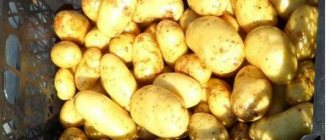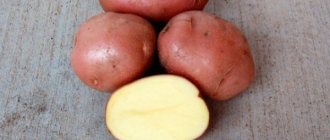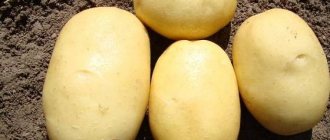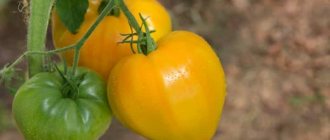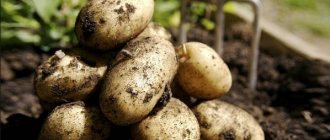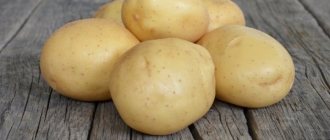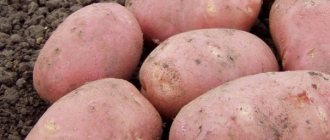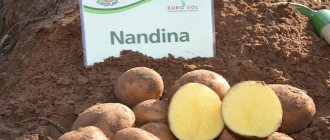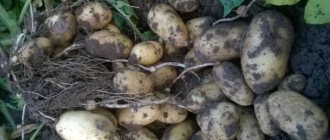History of the origin of potatoes
This variety was bred in 1987 by Ukrainian breeders.
Designed for cultivation in the following regions:
- North-West;
- Central;
- Ural;
- Srednevolzhsky;
- West Siberian;
- Far Eastern.
This variety can be grown both on personal farms and on an industrial scale.
“Svitanok” has an excellent presentation; it can be sold both immediately after collection and after a certain period of storage.
The table presents data on the mass of marketable tubers (grams) of different varieties:
| Name | Variety | Weight |
| Nikulinsky | Late ripening | From 70 to 120 |
| Cardinal | Late ripening | 65-110 |
| Rocco | Late ripening | 100-120 |
| Picasso | Late ripening | 80-140 |
| Borovichok | Early ripening | 120-200 |
| Elmundo | Early ripening | 120 |
| Felox | Early ripening | From 100 to 120 |
| Bellarosa | Early ripening | From 120 to 210 |
| Karatop | Extra early | From 58 to 100 |
| Zhukovsky early | Extra early | 100 to 120 |
| Farmer | Extra early | From 90 to 110 |
| Minerva | Extra early | From 120 to 245 |
| Sorcerer | Mid-late | From 75 to 120 |
| Mozart | Mid-late | From 100 to 150 |
| Grenada | Mid-late | From 800 to 100 |
| Melody | Mid-late | From 95 to 180 |
| Giant | Mid-early | 100-140 |
| Tuscany | Mid-early | From 90 to 125 |
| Purple Haze | Mid-early | From 90 to 160 |
| Openwork | Mid-early | 90-120 |
Disease Prevention
Svitanok Kiev quite easily survives all diseases that can affect the nightshade family. It is not affected by fungal infections, potato canker, all known viruses and nematodes. But prevention will never be superfluous if you need to get a large harvest.
As a preventive method, you need to plant seed in different areas every year. Also, during fruit harvesting, you need to collect all the tubers. If they begin to decompose, they can create a suitable environment for pests. But, this type of potato can be affected by wireworm or Colorado potato beetle. Therefore, experienced experts recommend using chemical herbicides before planting seeds in the soil.
Description of the variety
This is a universal variety with high yield. Ripens in 85-105 days. There are from 8 to 12 tubers in one bush. The peel is pink, the flesh is creamy.
The bush is small, upright, there is not much greenery, the leaves are small. The flowers are pale purple or red.
It has excellent productivity. So, from one hundred square meters you can harvest from 200 to 300 kg of potatoes. Ripening will depend on climatic conditions. For example, in warm regions the harvest is harvested as early as June, and in colder regions - by August.
Advantages and disadvantages
Pros:
- precocity;
- friendly maturation;
- marketability and keeping quality of the crop;
- resistance to viral and fungal pathogens;
- cold resistance;
- high percentage of starch (18-19%);
- tolerance to dry periods;
- dining versatility;
- significant harvests;
- excellent internal texture;
- transportation without mechanical damage.
Minuses:
- risk of late blight.
Peculiarities
“Svitanok Kyiv” is distinguished by the following characteristics:
- Easy to care for and plant, does not require additional agrotechnical techniques and knowledge;
- The seed material does not degenerate, it does not need to be additionally fed;
- It germinates well, without additional stimulation;
- Loves moderately moist, not wet, soil;
- From the moment of emergence of seedlings to the ripening of tubers, 70 days pass.
IMPORTANT: If desired, this type of potato can be fed with ammonium nitrate and superphosphate immediately before watering.
Description of potatoes Svitanok Kyiv
Svitanok Kiev potatoes have gained great popularity in Europe and Asia. Its fruits have high taste, long shelf life and versatility in preparation. It does not require special preferences in care, and is perfectly used both on farmland and for industrial purposes.
Description of potatoes Svitanok Kyiv
Correct fit
To get a high yield of “Svitanka”, it is enough to follow the following planting rules:
- In the fall, you need to dig up and fertilize the soil well;
- In the spring, clear it of weeds and mark the rows;
- Tubers must first be treated with copper sulfate, “Tabu”, “Prestige” - such preparations will protect against diseases and stimulate growth;
- Potatoes are planted at 8–10 cm. The distance between tubers is 30 cm, between rows is 70 cm;
- The beds are arranged from north to south.
ATTENTION: Good predecessors for potatoes are legumes, cabbage, pumpkin, cucumbers, and root vegetables.
Adretta potatoes. Care instructions
To increase the yield of the variety, as well as prevent spoilage of the tubers, potatoes must be properly cared for. Weeding, watering, hilling, pest and disease control will allow you to grow large and healthy potatoes.
Hilling
Hilling up potatoes is a mandatory procedure in growing technology. It is necessary to retain moisture, form new roots and tubers, and saturate the soil with oxygen. Plants are earthed up twice per season. The first hilling is done when the seedlings appear 8-10 cm above the soil, the second when the plant height is 20 cm.
Plant potatoes in the morning or evening, since the midday sun has a destructive effect on the plants.
In hot and dry climates, when there is no systematic watering, the plants do not spud. In loose, dry soil, the tubers bake. In this case, the soil is loosened between the rows, weeds are pulled out and dry lumps are destroyed for air exchange and plant growth.
Adretta potatoes do not tolerate drought and stagnant water. Therefore, keep the soil moist and water the potatoes as needed. One bush needs 3-4 liters of liquid. Water the bushes by sprinkling or in specially formed furrows.
It is recommended to fertilize in the morning or evening, but it is better to choose windless days with dry weather.
- If the shoots grow weak and thin, and the leaves look painful, apply the first part of the fertilizer. Dilute 1 tbsp in 10 liters of water. l. urea or ammonium nitrate. A solution of fresh mullein or bird droppings in a ratio of 0.5 liters per 10 liters of liquid is also useful. 500 ml of fertilizer is applied to each plant.
- When buds form on the tops, a second feeding is carried out to bring flowering closer. In 10 liters of liquid, dilute 3 tbsp. l. ash and 1 tbsp. l. potassium sulfate. 500 ml of fertilizer is poured under each bush.
- The third feeding is done at the time of flowering in order to enhance the growth of tubers. To make the desired mixture, dissolve 200 grams of fresh mullein or bird droppings in a bucket of water, and then add 2 tbsp to the resulting solution. l. superphosphate. Fertilizer is poured 500 ml under each plant.
Care
This variety requires compliance with the following care requirements:
- Weeding a week after planting;
- Hilling up bushes, which not only protects against weeds, but also allows oxygen to enter the soil;
- Moderate watering - excess moisture has a bad effect on the root system.
You can feed potatoes several times during their growth. The last such event should occur a week before harvesting.
Characteristics of potato varieties: American, Latona, Svitanok Kyiv, Molly:
Harvest and storage
Potatoes are harvested in late August - early September. By this time, the tops usually lie down and dry out. If the stems are still green, they need to be mowed 2 weeks before harvesting. This will speed up the ripening of root vegetables and the hardening of the skin. Digging up potatoes of this variety is quite convenient, since the tubers in the nests are compact. The harvested crop must be dried in air for several hours.
Then the root crops need to be sorted into large, small, damaged and seeded. First of all, you will need to use damaged potatoes, then small ones. The sorted potatoes are put into boxes and put into the cellar. The storage temperature should be +2...+4°C and humidity 90–92%.
You may be wondering if you need to wash your potatoes before storing them.
In such conditions, tubers can last even until a new harvest, remaining beautiful and tasty. Many gardeners have been growing Alvar potatoes on their plots for many years. They prefer it to other varieties for its unpretentiousness, stability and good taste.
Diseases and pests
Potatoes “Svitanok Kievskiy” are not susceptible to nightshade diseases. But for prevention, it is worth changing the fields, having first dug up all the tubers. The fact is that as they decompose, they will serve as food for insects.
This variety can be affected by Colorado potato beetles and wireworms.
We invite you to familiarize yourself with potato varieties that have different ripening periods:
| Late ripening | Early ripening | Very early | Mid-late | Mid-early |
| Nikulinsky | Borovichok | Forty days | Crane | Yanka |
| Cardinal | Elmundo | Karatop | Sorcerer | Giant |
| Rocco | Felox | Riviera | Mozart | Tuscany |
| Kiwi | Bellarosa | Zhukovsky early | Grenada | Purple Haze |
| Ivan da Marya | Natasha | Farmer | Melody | Openwork |
| Picasso | Ariel | Minerva | Margarita | Santana |
| Asterix | Queen Anne | Veneta | Ramona | Desiree |
| Slav | Arosa | Kiranda | Dolphin | Lady Claire |
Zoned potato varieties. Potato agricultural technology in the Black Earth Region
Growing potatoes in the Black Earth Region requires taking into account certain features. The Voronezh region is located in the Middle Zone, closer to the south. Almost 80% of the soil is chernozem or meadow-chernozem. This is the most fertile soil. Climatic conditions also allow for the cultivation of many vegetable crops and high yields. However, before planting potatoes, it is worth correctly selecting and zoning the most suitable varieties.
What to look for when choosing a variety
When choosing a suitable variety, you should give preference to those species that have already been tested by time and other people. It is not recommended to choose tubers intended for southern regions, because there may not be any results.
Potatoes in the Voronezh region always grow excellent
Important! When selecting potato types, attention is paid to its size, ripening time, yield, taste and ability to withstand various diseases. Productivity is one of the important characteristics. It will be a shame to invest a lot of effort and end up with small tubers
It is worth considering your own abilities; for beginners it is better to choose unpretentious varieties
It will be a shame to invest a lot of effort and end up with small tubers. It is worth considering your own abilities; for beginners it is better to choose unpretentious varieties
Productivity is one of the important characteristics. It will be a shame to invest a lot of effort and end up with small tubers. It is worth considering your own abilities; for beginners it is better to choose unpretentious varieties.
It is recommended to pay attention to the timing of crop ripening. Early ripening varieties with good care allow you to get a harvest even a couple of times a year
However, late-ripening potatoes are tastier and last longer.
Resistant to moisture and disease
When choosing a potato variety for planting in the Chernozem region and the Belgorod region, you need to take into account its ability to withstand prolonged rains. High humidity often causes the development of fungal diseases. Therefore, it is also worth carefully choosing a species based on its ability to resist various diseases. It is better to give preference to varieties that are more resistant. In this case, the likelihood of getting a good harvest increases significantly. Also, do not forget about the prevention of Colorado potato beetles.
It is recommended to pay attention to the size and quality of the tubers. Do not take potatoes that are too small or fruits with signs of disease or damage.
It is better if there are from 2 to 5 sprouts on the tuber, such a plant will develop faster and more successfully.
Agricultural technology of culture
Svitanok Kyiv is grown on any type of soil, but the maximum result is obtained when planted in sandy loam soil, generously flavored with organic matter and minerals.
Planting care is minimal and does not require professional skills. It is enough to moderately water the bushes, hill up the beds, loosen the soil, remove weeds and apply organic and mineral fertilizers.
Preparing for landing
Three weeks before planting in the ground, selected tubers are taken out of the basement and placed in sunlight for germination. The material is treated with a pink solution of potassium permanganate and soaked in Fitosporin.
In practice, disinfectant liquid is often used:
- potassium permanganate – 1 g;
- boric acid – 10 g;
- superphosphate – 60 g;
- urea – 40 g;
- copper sulfate – 5 g;
- hot water (80°C) – 10 l.
The components are thoroughly mixed until completely dissolved and the tubers are soaked in a warm solution for 20 minutes.
Immediately before planting in the soil, the seed material is treated with germination stimulants “Zircon”, “Epin”, “Poteitin”, “Fumar”.
Timing, scheme and technology of planting
Potatoes are planted in the second ten days of April or the first ten days of May, depending on the climate. The soil temperature should be at least +7°C.
In the fall, the site is dug up and fertilized:
- organic matter - cow (50-100 kg per 100 sq. m) or horse (40-80 kg per 100 sq. m) manure;
- minerals - superphosphate (2 kg per 100 sq. m) or potassium chloride (1.5 kg per 100 sq. m).
A month before the intended planting, the area is sown with green manure (lupine, rye, wheat, peas, flax), then mowed and dug into the soil. Rotted greens loosen the soil, saturate it with air and prevent the growth of pathogenic fungi.
Seeds are planted to a depth of 10 cm, with an interval of 30-35 cm. The width between rows is 70 cm.
Place a handful of wood ash and potatoes with the sprouts facing up in each hole. Large tubers are cut into pieces and the cut is sprinkled with ash.
Reference. Tubers of the Svitanok variety are not prone to degeneration and loss of original qualities, so seed replacement is not required.
To get a rich harvest, follow the rules of planting care:
- Potatoes Svitanok prefer moderate watering - once every 10-12 days. An excess of moisture leads to cracks in the tubers, and a deficiency leads to the death of the root system. The optimal solution is to install drip irrigation on the site.
- To prevent a hard crust from appearing on the surface of the earth, loosening is carried out after watering.
- Weeding begins seven days after planting.
- Hilling of the bushes is carried out twice: when the shoots extend 15 cm, and again during the flowering period.
- Harrowing is carried out on areas of more than three acres. A harrow is attached to the tractor or engine block, the teeth of which pull out weeds and deeply loosen the ground.
- Potatoes gain green mass more actively and form tubers if the bushes are fed with foliar fertilizers. For example, Finnish farmers reap a record harvest when applying foliar mineral fertilizers once every 10–14 days.
Recommended fertilizer application schedule:
- before flowering - 50 g of urea, 5 g of boric acid, 75 g of potassium monophosphate per 10 liters of water;
- during the flowering period - 20 g of superphosphate, 2 g of potassium chloride, 2 g of ammonium nitrate, 0.1 g of copper sulfate per 10 l;
- after flowering - 5 g of boric acid, 2 g of potassium permanganate per 10 l.
Advice. If the seedlings have been damaged by frost or hail, feed them with Zinc Chelate, Brexil, Reacom-SR-Potato fertilizers and growth stimulants Poteytin and Megafol.
Disease and pest control
The culture is immune to potato cancer and black scab, moderately resistant to blackleg, common scab and viruses, and susceptible to late blight.
Phytophthora reproduces by zoospores, which survive even in an unfavorable environment and quietly overwinter in the soil, plant debris, and on working tools. At an air temperature of +10°C and a humidity of 80-90%, spores germinate. The incubation period lasts from 3 to 16 days and is initially unnoticed. Then dark brown spots and a whitish coating on the back side appear on the leaves. Brown spots and traces of rot are visible on the tubers.
Reviews from vegetable growers
“Svitanok Kyiv” is one of the few potato varieties that are loved by gardeners due to stable and high yields, regardless of weather conditions. Reviews about this variety are positive, and the assessment of the quality indicators of the tubers is very high. When growing, it is very important to observe planting dates, focusing on the characteristics of the climatic zone. The variety does not do well when grown on depleted and salty soils, which requires the use of high-quality fertilizers.

